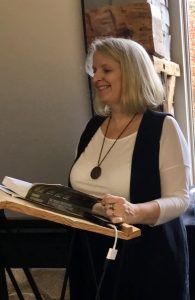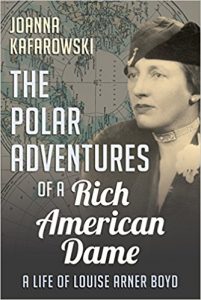Writing Biography: How Obstacles Made Me A Better Writer
 Invariably, the first question I get asked at book signings is how did I learn about Louise Arner Boyd and why did I write about her? While it’s difficult to identify that exact moment when the spark was lit and I committed to writing her life story, it all began in the remote wilderness of the Arctic.
Invariably, the first question I get asked at book signings is how did I learn about Louise Arner Boyd and why did I write about her? While it’s difficult to identify that exact moment when the spark was lit and I committed to writing her life story, it all began in the remote wilderness of the Arctic.
Following the lure of the North, I was working in an Inuit community in Canada while studying for my PhD in Natural Resources and Environmental Studies. A voracious reader with a fondness for books about polar exploration, I was intrigued by a passing reference to an unusual American woman sailing the coast of East Greenland in the 1930’s.
The name “Louise Arner Boyd” was filed away somewhere in my brain until my doctoral fieldwork was complete. Upon my return to Prince George, British Columbia, I searched for her biography. To my chagrin, I learned that there were a few children’s books about her and several general titles about women explorers but no full biography. My interest in this enigmatic woman grew. A few months later, a family vacation in California lead to the unexpected discovery of the Marin History Museum which held significant holdings related to Miss Boyd.
While my family frolicked at the beach, I spent a few happy hours rummaging around the dusty archives uncovering tarnished medals she had been awarded and reading through piles of tattered letters from notable women and men. By the time I emerged into the blinding sunlight, I was hooked. I would write the first comprehensive biography of this extraordinary individual who was an explorer, scientist, socialite, photographer, philanthropist and geographer.
Initially, I was drawn to Louise Arner Boyd as a biographical subject because we were both geographers who shared a passion for the Arctic. I worked in natural resource management which, like polar exploration, was dominated by men. We both chose life paths that were unconventional for women. Over time, as I dug deeper into the research, my respect and admiration for all she accomplished grew.
As her biographer, I knew that the research and writing process meant undertaking a long journey- both literally and metaphorically. But I never anticipated that it would take over ten years. Now that the book has been published, I can see how this lengthy gestation period has benefitted me as a writer- made me stronger, more resilient and committed in my chosen métier.
In my quest to find Louise Arner Boyd, I criss-crossed North America and Scandinavia searching for people who knew or worked with her. I located documents and artifacts that shed light on her courageous decision to defy societal expectations and follow her dreams to the Arctic. I never expected it to be easy but I was confounded by territorial museum staff who refused me access to key archives; suspicious family members of friends who jealously safeguarded their ancestor’s memory and bureaucratic regulations limiting the access of foreigners to documents about a long-dead explorer. The vagaries of my own life interfered with my journey as well. I was spoiled for choice regarding excuses for not continuing.
The path to write this book has been an arduous one. At some point or another, most writers experience a loss of confidence in themselves or their project or come up against insurmountable writer’s block. I struggled with my writing style and, at times, fought against the academic tone I had adopted while a university lecturer. I persevered without any interest from a literary agent or publisher. I wonder now what would have been different if things had been easier for me. At times, I bemoan the fact that I could have written and published another book if my biography of Louise Arner Boyd had been published sooner. And yet, most of the time, I believe that I am a better writer because of the obstacles I had to overcome.
Pushing back against the naysayers meant that I had decided that the life of this remarkable woman was worth the time, effort and money that I had invested. Learning about a new critical document that had come to light in a library halfway across the world meant that I had to weight up its value to my story. Would I cut corners because I wanted to publish sooner?
And so, I proceeded slowly and with meticulous care. This was her first comprehensive biography and I was determined to do right by her. Ultimately, I did the work because I loved it- because the voice of Louise Arner Boyd in my head was so loud and insistent and because it was something I knew I had to do. My inner voice told me to stay the course with Miss Boyd and I did so.
As her story came together over the years, I honed my craft further. Always a perfectionist, I was reluctant to finally admit to myself that it was time to submit to a publisher. The desire to follow another lead; to check out another source was strong within me but it was time to let her go out into the world.
After “The Polar Adventures of a Rich American Dame A Life of Louise Arner Boyd” was accepted by Dundurn Press, I knew that my mission to spread the news about Louise Arner Boyd far and wide would come to pass. If I can sell books along the way, then all the better. But this journey with Louise Arner Boyd has been forged in fire and I have emerged stronger as a writer on the other side.
—
Find out more about Joanna on her website https://joannakafarowski.com/
Facebook; https://www.facebook.com/joannakafarowski
The Polar Adventures of a Rich American Dame: A Life of Louise Arner Boyd
 The first comprehensive biography of Louise Arner Boyd ― the intrepid American socialite who reinvented herself as the leading female polar explorer of the twentieth century.
The first comprehensive biography of Louise Arner Boyd ― the intrepid American socialite who reinvented herself as the leading female polar explorer of the twentieth century.
Born in the late 1880s to a gritty mining magnate who made his millions in the California gold rush and a well-bred mother descended from one of New York’s distinguished families, society beauty Louise Arner Boyd was raised during a glittering era.
After inheriting a staggering family fortune, she began leading a double life. She fell under the spell of the north in the late 1920s after a sailing excursion to the Arctic Ocean. Over the next three decades, she achieved international notoriety as a rugged and audacious polar explorer while maintaining her flamboyant lifestyle as a leading society woman. Yet despite organizing, financing, and directing seven daring Arctic expeditions between 1926 and 1955, she is virtually unknown today.
Category: Contemporary Women Writers, How To and Tips


























Lovely piece Joanna. As a yet unpublished writer, with five years into my manuscript, I’m inspired. Also wonderful to learn of another woman explorer. Thanks.